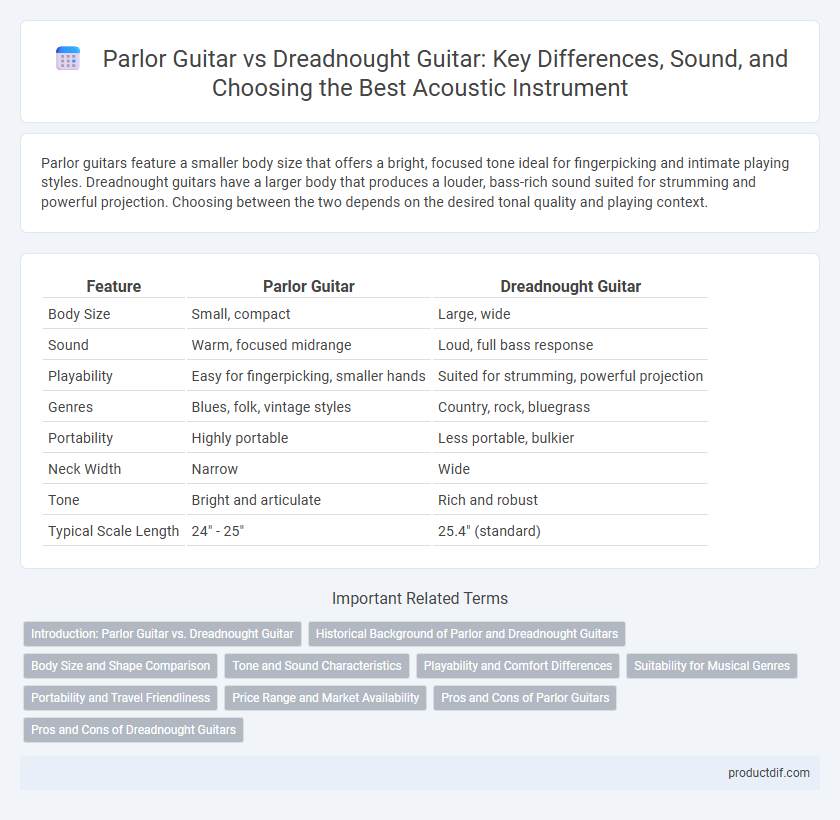Parlor guitars feature a smaller body size that offers a bright, focused tone ideal for fingerpicking and intimate playing styles. Dreadnought guitars have a larger body that produces a louder, bass-rich sound suited for strumming and powerful projection. Choosing between the two depends on the desired tonal quality and playing context.
Table of Comparison
| Feature | Parlor Guitar | Dreadnought Guitar |
|---|---|---|
| Body Size | Small, compact | Large, wide |
| Sound | Warm, focused midrange | Loud, full bass response |
| Playability | Easy for fingerpicking, smaller hands | Suited for strumming, powerful projection |
| Genres | Blues, folk, vintage styles | Country, rock, bluegrass |
| Portability | Highly portable | Less portable, bulkier |
| Neck Width | Narrow | Wide |
| Tone | Bright and articulate | Rich and robust |
| Typical Scale Length | 24" - 25" | 25.4" (standard) |
Introduction: Parlor Guitar vs. Dreadnought Guitar
Parlor guitars feature a smaller body size, producing a warm, balanced tone ideal for fingerstyle and intimate settings, while dreadnought guitars offer a larger body that delivers powerful, robust sound with strong bass response, favored for strumming and flatpicking. The compact dimensions of parlor guitars make them highly portable and comfortable for smaller players, whereas dreadnoughts are a staple in bluegrass and acoustic rock due to their volume and projection. Choosing between parlor and dreadnought guitars depends largely on playing style preferences and the tonal qualities desired.
Historical Background of Parlor and Dreadnought Guitars
Parlor guitars gained popularity in the late 19th and early 20th centuries, favored for their smaller size and intimate sound ideal for home performances. Dreadnought guitars were introduced by Martin in 1916, featuring a larger body designed to provide greater volume and bass response, revolutionizing folk and bluegrass music. The distinct historical development of these guitars reflects their adaptation to different musical styles and performance settings.
Body Size and Shape Comparison
Parlor guitars have a smaller, more compact body size with a narrow waist, making them lightweight and comfortable for fingerstyle playing. Dreadnought guitars feature a larger, broader body with squared shoulders, producing a louder and deeper sound ideal for strumming and flatpicking. The size and shape differences directly influence tonal projection and playability, with parlor guitars emphasizing clarity and dreadnoughts delivering powerful bass response.
Tone and Sound Characteristics
Parlor guitars produce a warm, intimate tone with enhanced midrange frequencies, making them ideal for fingerpicking and blues styles. Dreadnought guitars deliver a powerful, balanced sound with strong bass response and loud volume, suited for strumming and accompaniment. The smaller body of the parlor guitar emphasizes clarity and articulation, while the larger dreadnought body provides greater projection and resonance.
Playability and Comfort Differences
Parlor guitars feature a smaller body size and narrower neck, enhancing playability and comfort for fingerstyle players and those with smaller hands. Dreadnought guitars have a larger body and wider neck, providing more volume but potentially less comfort during long playing sessions. Players seeking ease of handling and reduced arm fatigue often prefer parlor guitars over dreadnought models.
Suitability for Musical Genres
Parlor guitars, with their smaller body and warm, focused tone, excel in folk, blues, and fingerstyle genres that benefit from intimate, nuanced sound. Dreadnought guitars feature a larger body and powerful projection, making them ideal for bluegrass, country, and rock styles that require strong volume and bass response. Choosing between the two depends on the musical genre's demand for either delicate articulation or robust sound presence.
Portability and Travel Friendliness
Parlor guitars are significantly more portable due to their smaller body size and lighter weight, making them ideal for travel and easy to carry in compact cases. Dreadnought guitars, while offering more volume and bass response, are bulkier and less travel-friendly, often requiring larger gig bags or hard cases. Musicians seeking convenience and mobility often prefer parlor guitars for on-the-go playing without sacrificing tonal quality.
Price Range and Market Availability
Parlor guitars typically range from $150 to $800, appealing to budget-conscious players and niche markets, while dreadnought guitars often cost between $200 and $1,500, reflecting their widespread popularity and mass production. Parlor guitars are less common in mainstream music stores, often found in specialty shops or online boutiques, whereas dreadnought guitars enjoy broad availability worldwide through major retailers and numerous brands. The price variation and market presence highlight dreadnought guitars as more accessible and versatile for a wider range of consumers.
Pros and Cons of Parlor Guitars
Parlor guitars offer superior portability and a balanced tone with clear mids, making them ideal for fingerstyle players and intimate performances. Their smaller body size limits volume and bass response compared to dreadnought guitars, which may be a drawback for players seeking powerful projection and deep lows. While parlor guitars excel in comfort and articulation, they are less suited for heavy strumming or band settings that benefit from the robust sound of dreadnoughts.
Pros and Cons of Dreadnought Guitars
Dreadnought guitars are renowned for their powerful, bass-heavy sound and large body, making them ideal for strumming and flatpicking in genres like bluegrass and country. Their robust volume and strong projection suit live performances but can be cumbersome for smaller players due to the larger body size. While offering excellent tonal depth and sustain, dreadnoughts may lack the intimate comfort and nuanced articulation found in smaller-bodied guitars such as parlors.
Parlor guitar vs Dreadnought guitar Infographic

 productdif.com
productdif.com